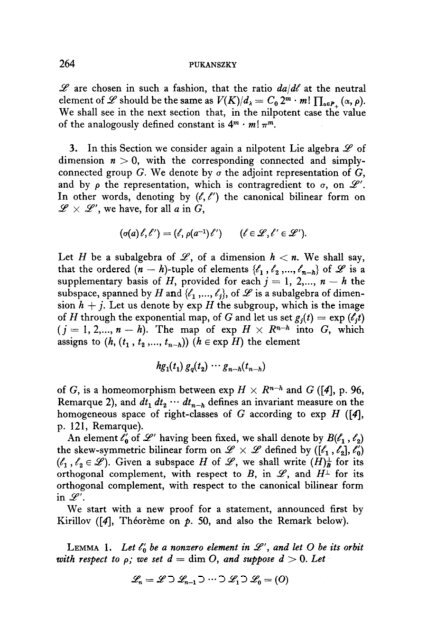On the Characters and the Plancherel Formula of Nilpotent Groups ...
On the Characters and the Plancherel Formula of Nilpotent Groups ...
On the Characters and the Plancherel Formula of Nilpotent Groups ...
You also want an ePaper? Increase the reach of your titles
YUMPU automatically turns print PDFs into web optimized ePapers that Google loves.
264 PUKANSZKY<br />
2 are chosen in such a fashion, that <strong>the</strong> ratio da/d/ at <strong>the</strong> neutral<br />
element <strong>of</strong> 2 should be <strong>the</strong> same as V(K)/d, = C, 2” * m! nasP+ (a, p).<br />
We shall see in <strong>the</strong> next section that, in <strong>the</strong> nilpotent case <strong>the</strong> value<br />
<strong>of</strong> <strong>the</strong> analogously defined constant is 4” * m! rrm.<br />
3. In this Section we consider again a nilpotent Lie algebra P’ <strong>of</strong><br />
dimension n > 0, with <strong>the</strong> corresponding connected <strong>and</strong> simply-<br />
connected group G. We denote by u <strong>the</strong> adjoint representation <strong>of</strong> G,<br />
<strong>and</strong> by p <strong>the</strong> representation, which is contragredient to u, on 2’.<br />
In o<strong>the</strong>r words, denoting by (/, el) <strong>the</strong> canonical bilinear form on<br />
2 x ZZ”, we have, for all a in G,<br />
(u(a) rt, P) = (l, p(a-‘) 8’) (t E Y, t’ E 9’).<br />
Let H be a subalgebra <strong>of</strong> 2, <strong>of</strong> a dimension h < n. We shall say,<br />
that <strong>the</strong> ordered (n - h)-tuple <strong>of</strong> elements {t; , /a ,..., &‘n-h} <strong>of</strong> $P is a<br />
supplementary basis <strong>of</strong> H, provided for each j = 1, 2,..., n - h <strong>the</strong><br />
subspace, spanned by H<strong>and</strong> (8, ,..., e,>, <strong>of</strong> 2 is a subalgebra <strong>of</strong> dimen-<br />
sion h + j. Let us denote by exp H <strong>the</strong> subgroup, which is <strong>the</strong> image<br />
<strong>of</strong> H through <strong>the</strong> exponential map, <strong>of</strong> G <strong>and</strong> let us set gj(t) = exp (J’+)<br />
(j = 1, 2,..., 12 - h). The map <strong>of</strong> exp H x Rn-h into G, which<br />
assigns to (h, (ti , t, ,. .., tn-h)) (h E exp H) <strong>the</strong> element<br />
<strong>of</strong> G, is a homeomorphism between exp H x Rn-h <strong>and</strong> G ([4J p. 96,<br />
Remarque 2), <strong>and</strong> dt, dt, *a+ dt,-, defines an invariant measure on <strong>the</strong><br />
homogeneous space <strong>of</strong> right-classes <strong>of</strong> G according to exp H ([4J,<br />
p. 121, Remarque).<br />
An element c!; <strong>of</strong> 2’ having been fixed, we shall denote by B(lr ,&J<br />
<strong>the</strong> skew-symmetric bilinear form on 9 x 2 defined by ([/r , t.J, 8;)<br />
(/i , tz E 2). Given a subspace H <strong>of</strong> JZ’, we shall write (H)i for its<br />
orthogonal complement, with respect to B, in 2, <strong>and</strong> H-L for its<br />
orthogonal complement, with respect to <strong>the</strong> canonical bilinear form<br />
in 9’.<br />
We start with a new pro<strong>of</strong> for a statement, announced first by<br />
Kirillov ([4], Theo&me on p. 50, <strong>and</strong> also <strong>the</strong> Remark below).<br />
LEMMA 1. Let & be a nonzero element in 9”, <strong>and</strong> let 0 be its orbit<br />
with respect to p; we set d = dim 0, <strong>and</strong> suppose d > 0. Let

















